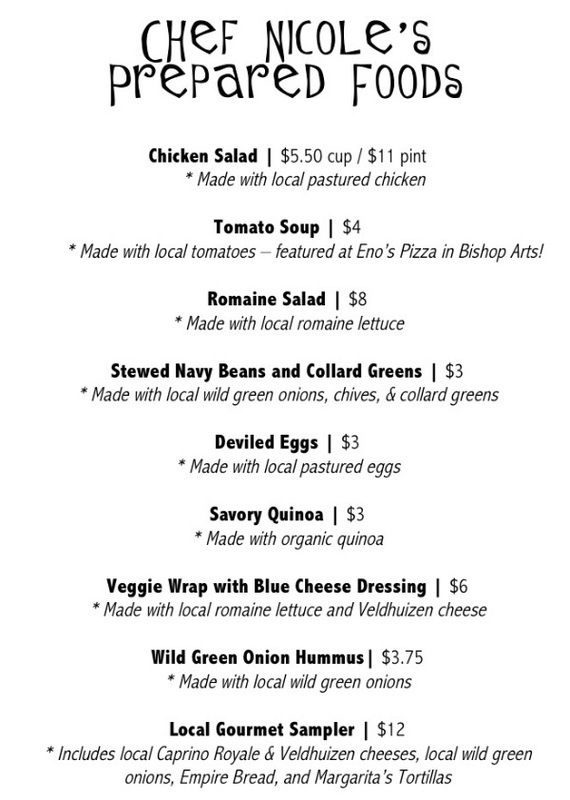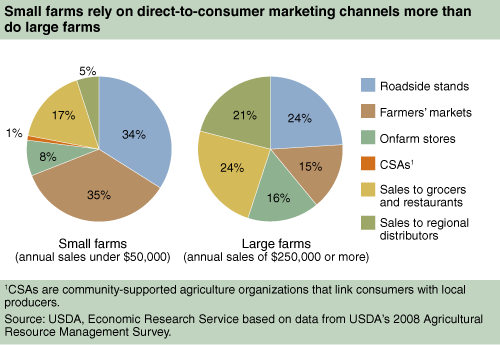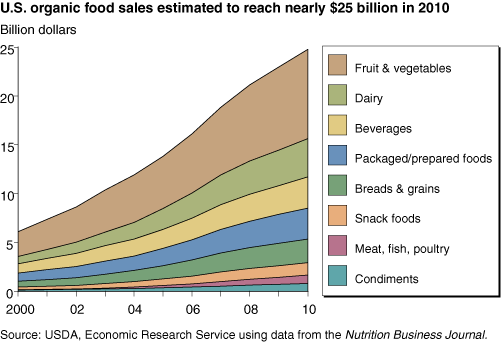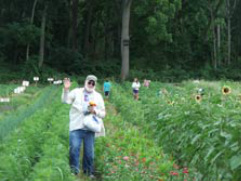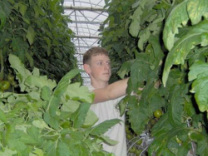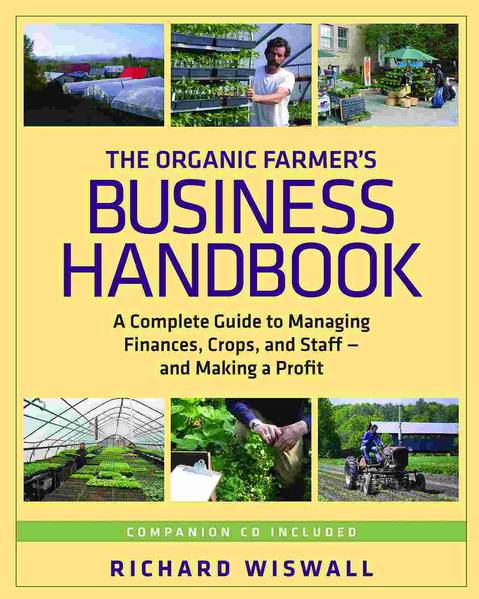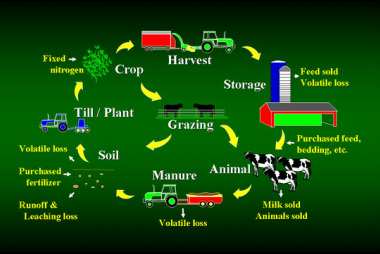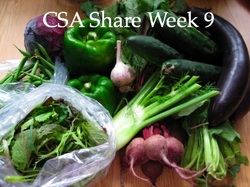
The CSA: A vital tool for small farms near urban populations.
Market and Business Savvy
Being in the right place at the right time with the right product is not just a matter of circumstance; it’s a product of research and planning. One of the main objectives of proper planning is to relegate the element of luck to the most minor status. Prior to marketing, it is important to identify what markets exist, what products work the best within these markets, and what product characteristics maximize demand and profit margins. The importance of the marketing aspect of farming cannot be understated . Not to be confused with advertising or selling, in business, a good marketing strategy creates opportunity and often means the difference between mere subsistence and making a fair profit. Marketing is a never-ending process and new market opportunities keep a farm vital and alive. Opportunities to sell are the product of good and diligent research with aggressive follow-up and in the business of farming should, in reality, be on a par with milking the cows, tilling the soil and irrigating the crops.
Being in the right place at the right time with the right product is not just a matter of circumstance; it’s a product of research and planning. One of the main objectives of proper planning is to relegate the element of luck to the most minor status. Prior to marketing, it is important to identify what markets exist, what products work the best within these markets, and what product characteristics maximize demand and profit margins. The importance of the marketing aspect of farming cannot be understated . Not to be confused with advertising or selling, in business, a good marketing strategy creates opportunity and often means the difference between mere subsistence and making a fair profit. Marketing is a never-ending process and new market opportunities keep a farm vital and alive. Opportunities to sell are the product of good and diligent research with aggressive follow-up and in the business of farming should, in reality, be on a par with milking the cows, tilling the soil and irrigating the crops.
Twelve Proven Marketing Strategies Ready to Go Today!Community Supported Agriculture Enterprise: This strategy with its roots in the environmental movement begun in the 1960's, is a time-tested model that in its essence is the ultimate and most direct link between the farmer and local consumer. Consumers buy a share in the future production of the farm, usually in advance, and then receive fresh produce (as often as weekly) throughout the growing season. From a business perspective, the CSA can be a valuable source of cash in the off-season with pre-paid subscriptions. Among the benefits of a prepay system is the fact that these funds can help mitigate start-up costs in the spring when, traditionally, cash positions are tight. Moving forward it is important to note that through innovative thinking, the CSA model can be combined with other discusssed marketing methods to form hybidized CSA's. Among these hybrids would be CSA U-pick, CSA Farm wineries or product processing facilities, CSA Farm-Restaurant partnerships, and CSA Organic Farms. (1)(2)(3)
|
Community Farmer's Markets:. Since 1994, Farmer's Markets in the United States have grown from 1,755 to 7,100 (2011). These markets provide another direct link to the local consumer with a minimal investment and ready exposure to a target group that is willing and able to buy. Beyond access to the direct consumer, Farmer's Markets located in or near large urban areas often act as conduit to wholesalers and restaurants, and can be valuable in establishing relationships beyond the Farmer's Market. Because of its relative simplicity, this marketing and selling vehicle presents an excellent "entry-level" opportunity for the small and beginning farmer with minimal risk. Additionally, new-comers can gain valuable marketing experience selling "side-by-side" with established veterans. The USDA estimates that in 2008, the direct-to-consumer fresh produce market grossed over $4.8 billion. Again, with innovation, the Farmer's Market can become an outlet that can form a foundation for hybrid combinations that extend the season for stored and late season produce like apples and root crops, as well as farm-produced or processed foods. (4)(5)
The Roadside Stand : This iconic symbol of the American family farm, and the rural countryside, can also be a major profit center for the small farm and a hub for farm activity. Reported farm income from roadside stands nationwide in 2008 was over $254 million or 29% of all direct-to-consumer farm produce sales ($877 million).* Average expenditures by customers of the roadside stand range from $11 to $19 per visit; and the average number of visits was 2.19 per customer per month. Farmers that utilize roadside stands along with the other aforementioned local marketing strategies work on average 300 more hours per year than their more conventional marketing counterparts but these same farmers relied on 17% less off-farm income to support their operations and family expenses. (6)(7)(8). |
|
Wholesale Markets: Moving a lot of product quickly is the chief advantage of the wholesale market. While roadside stands, CSA, and the farmer's market require a high level of customer service and personal involvement on behalf of the farmer, this type of marketing/selling involves a few key relationships with a limited number of agents or buyers. Because of the demand for large quantites, small farmers can band together to sell the same or similar crops to a single buyer or group of buyers with only one set of negotiations. Beyond the advantages of this strategy lies that facts that wholesale prices will be below the direct-marketing prices. Packing, cleaning, and a requisite general uniformity of the product are requirements that can also add extra labor and expense on the production side. While diversity is generally considered a key to the success of the small farm over the long term, farms that possess micro-climates or specific soil-types that are especially suited to growing a specific crop (ie: sandy loam for root crops or the tempering effect of a large body of water for fruit crops) can utilize wholesale outlets to move large quantities of these specific crops. It is important to note that wholesale marketing can be an excellent adjunct to other strategies, in that it paralells and complements the crop/product diversification strategy. (9)(10)(11)
|
Restaurants : Selling to restaurants requires a special skill-set from the farmer in that he must have the ability to develop a working and flexible relationship with the head chef, owner, or buyer. Once this relationship is established, the farmer can often influence what crops/products the restaurant buys and features. When the restaurant recognizes and trusts the farmer as a reliable source of high quality product, the restaurant can feature a farmer's product by name on the menu or in daily specials. This name-brand marketing will be a value added benefit that will carry-over to all segments of the farm marketing strategy. A key element that can influence buyers in this market would be the farmer's ability to offer semi-processed forms of his product such as peeled potatoes, washed and sliced carrots and certain produce chopped and salad- ready. Additionally, special "tags" such as "locally-grown," "ethically-raised" and "hormone-free" can enhance a menu and be a important selling and price point for the seller (farmer), buyer (restaurant) and consumer (restaurant patron). (12) (13)(14)(15). Tagging Your Product to Make It Unique: In every sector of commerce making a product unique so that buyers take notice is the essence of marketing and advertising. The successful marketeer searches trends and societal "quirks" and gears his product to appeal to those characteristics. Food socialogist Amy Guptill points out that " . . .all marketing involves emotional and conceptual symbols. Food corporations spend huge sums developing and promoting brands that people associate with 'wholesome goodness.' Small farmers can play that game either long distance (label/certification) or face-to-face (locally) and they have the (unique) advantage of authenticity." Over the course of time, a farm's name or region can become synonymous with quality or a certain desirable food characteristic, i.e.: Vidalia Onions, Horizon Milk (organic), Dole pineapple. Other key tags capitalizing on the health trend would include: "hormone-free", " anti-oxident", " no genetically enhanced ingredients," "free range." Creating brands that identify with traits or trends is a nuanced difference that sets a product apart from similiar competitors and ultimately brings a premium price. (16)(17)(18) link to a unique illustration of tagging for your market
|
|
Organic Farming : Retooling for the Future: Once the pariah of the commercial farming industry and the perceived bastion of kooks and hippies, organic farming is now the fastest growing sector of agriculture, producing products that command premium prices. Beyond the immensely important moral, ethical, and philosophical considerations for the small-scale farmer in this realm is the tremendous marketing opportunity organic farming presents. Currently, demand for organic products far exceeds the domestic supply and production-capacity of the number of existing U.S. organic farms. It is market so ripe that during the period 2000-2008, organic acreage increased 41%, dairy cows - 87k to 200k, and laying hens- 2.4 to 342 million. For established farmers full or partial conversion to organic methods can involve philosophical changes that go against the grain of practices that have been firmly entrenched since the end of World War II. and been abetted by the state and federal governments as well as the majority of land-grant colleges. Today, these same institutions have well- established and expanding support-systems in place to encourage and promote organic farming that lend scientific and economic aid and creedence to the movement.The federal 2012 Farm Bill contains solid funding for the sustainable and organic farming community with a myriad of grants and and opportunities for farmers seeking to convert acreage to organic culture or to begin organic operations.(19)(20)(21)
|
Grocery Stores and Locally Grown Produce: No marketing sector capitalizes on the "tagging your product strategy" like the retail- grocery store produce department. "Locally-grown" and health related tags, such as "heart-healthy", "organic" and "anti-oxident" all command particular attention from the consumer and premium pricing for the farmer in this market. Today, both chains and independent grocers aggressively seek and promote locally grown produce to the point of inviting local farmers to present their products in-store. The keys to gaining a foothold in this market are to actively develop a working relationship with the produce manager/buyer, consistantly deliver an on-time high-quality product, labeled and packed to the stores specifications and then maintain a communication link with the produce manager/buyer. Large quantities of product can be moved through this venue but it is important to realize that the price paid by the store will generally be 35-40% below that of the farmer's market and roadside stand. This pricing downside however, may be mitigated if the farmer is able to offer adequete supplies of unique products such as hierloom apples and vegetables and new variations of products with unique colors or flavor characteristics (seed companies and extension services can be helpful here). This niche marketing done in cooperation with the aggressive advertising generally provided by the store itself can create a premium market opportunity for both parties and a destination point for consumers looking for unique produce.(22)(23)(24). |
Bringing the Customer to the Farm
|
Multi-Crop U-Pick Operation : Long a staple of many small farms, the U-pick operation can be an even more important profit center and marketing opportunity for the modern farmer today. Suburban sprawl has moved consumers closer to farm operations making the logistics of "getting to the farm" more feasible. By utilizing Internet marketing, farmers can alert established customers to optimal picking times and introduce new varieties to these customers. When new customers visit the farm, savvy farm operators can obtain e-mail information and in turn, cultivate this information to create repeat business. In the past, the U-pick model specialized in a limited palette of produce with staples like strawberries, raspberries, and some tree fruits, particularly apples. The modern model looks to establish and extend a tight schedule of a sequence of crops that begin in the spring and end in the late fall. Offering more than one crop simultaneously ie: asparagus, early beets and beet greens, radish, peas, broccoli, strawberries, and early blueberries (as well as farm processed products) in the spring creates a more attractive "destination" for the u-pick client. New advances in mini-hoop house/polytunnel growing, early and short season varieties, and autumn sowing technology can be valuable tools in the quest to begin the season prior to traditional starting dates. Beyond high-quality produce that "out-qualities" grocery-store-available products, "thinking outside the traditional box" to enhance the visitors' experience can be a key to repeat business and higher-dollar-per-visit return: think fresh flowers, farm-grown nursery stock, and Christmas trees. (25)(26)(27)
|
Agri(o)tourism : In the past, the very thought of the farm as a recreational destination, beyond an occasional harvest celebration or a dude-ranch type scenario was relatively inconceivable. Today, by employing a number of on farm modifications, a good presentation, an Internet presence, and the proper insurance, the farm itself can become a profit center in concert with and beyond the products it produces.It is important to note that there is an extremely strong sense of nostalgia and reverence for farming in American culture that stems from the fact that the country was largely an agrian society until the turn of the century (1900) and one-in-five Americans lived and worked on farms into the mid-20th century. Trends in the general population's interests in health, nature, fresh food, and the popularity of "Bed and Breakfasts" all are postives that indicate that this already established niche will continue to grow. By the numbers, tourism/travel in the United States exceeds 1.3 trillion in revenue and accounts for 1 in 8 jobs with a payroll of $162 billion dollars. Many European farmers, have successfully melded farming operations with tourism, and in England for example, 23% of all farmers realize additional income from agritourism. Market ideas range from participation by guests in regular farming chores to hayrides, festivals, camping to cooking, trail biking, and educational and historic events.There are many precedents set, with the lead literature coming from Vermont, Washington state, and California. In an industry where off-farm income is often necessary for a farm's survival, agritourism presents many possibilities to keep family members actively involved in farming and farming operations. (28)(29)(30)(31)
|
|
On Farm Processing: Redefining the Meaning of the Factory Farm : Two of the basic tenets of the sustainable farm are diversity and flexibility. When a farm can offer a number of well-managed profit centers such as a Multi-crop U-pick Operation and a wine shop or cheese store, it possesses assets that can both complement each other and balance each other in a number of very important ways. Marketing venues that do not rely solely on a specific season or seasonal crop are created which in turn balance cash-flow, the backbone, and often the bain of many small businesses. With the ability to process meat or a crop (or group of crops like small fruits) which can be packaged and sold fresh, juiced, fermented, and cooked in various ways, the farmer "cuts out one middle-man" and reaps the higher processed premium for him/herself. In terms of initial investment, food processing equipment like washers, small to medium capacity commercial wine pressess, and commercial cooking and canning equipment are equivilent to the same investment a farmer would make in a tractor or piece of harvesting equipment. While additional training and personal may be required, along with the requisite licenses and permits, adding this type of value-added operation to the farm can mitigate the need for the farm family's long term reliance on outside income sources. (32)(33)(34)
|
|
Internet Marketing : The Door to Millions of New Customers : There is no tool or implement on the modern farm that has the value and versitility of the computer, specifically in terms of Internet access. In the realm of marketing, a small farmer with a modicum of training and the drive to learn and explore can compete in the same arena as companies with financing and resources that dwarf those of small farms. Beyond being a stand-alone strategy, Internet marketing is symbiotic with all other strategies and in some cases, such as Agritourism and CSA's, essential to success. Research confirmed by BIA/Kelsey, one of the nation's top marketing analysts, indicates that in current markets, ninety-seven percent of consumers use some form of Internet marketing to make their buying decisions and plan their shopping. Beyond the opportunity for the farmer to be actively involved in the Internet marketing process are Internet marketing services and cooperative that fill the role of e-tailers for small farms; examples of which include Foodzie and Local Harvest. As cyber-technology advances and shipping methodolgy continues to evolve, the role of Internet marketing will become an increasingly important elemental strategy for the survival of the small farm moving forward into the new millenium. (35)(36)(37)
Discussing Farming in the Context of a Business: A Few Points to Ponder
Going Forward
|
|
